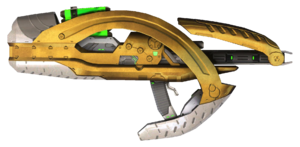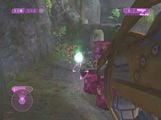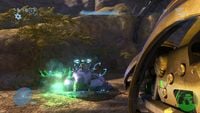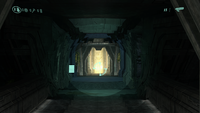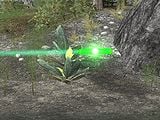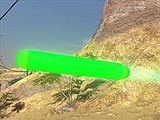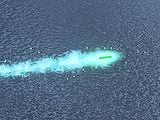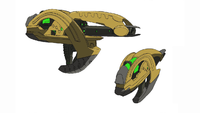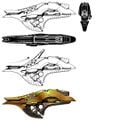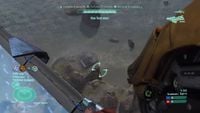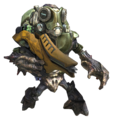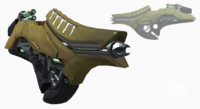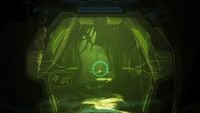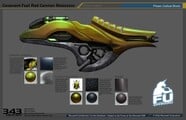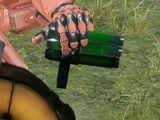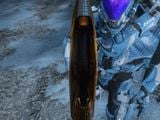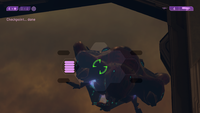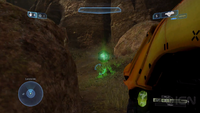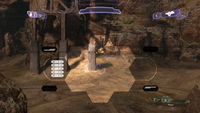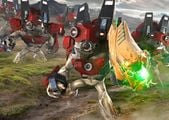Pez'tk-pattern fuel rod gun
From Halopedia, the Halo wiki
| Pez'tk-pattern fuel rod gun | |
|---|---|
| Production overview | |
|
Manufacturer: |
|
|
Model series: |
Type-33 |
|
Type: |
Light Anti-Armor Weapon |
| Specifications | |
|
Length: |
|
|
Width: |
18.5 centimetres (7.3 in)[5] |
|
Height: |
54.7 centimetres (21.5 in)[5] |
|
Weight: |
|
|
Ammunition type: |
Class-2 38mm radioactive explosive fuel rods |
|
Feed system: |
5 rounds magazine[3] |
|
Recoil-operated | |
|
2 rounds/second (semi-automatic) | |
|
72 m/s (236 ft/s)[4] | |
|
Effective range: |
165 metres (540 ft)[4] |
| Service history | |
|
In service: |
|
- "Those things are scary as hell. Ya hear that weird “whump” sound and even if ya see it comin' you're transfixed, these big green blobs flying at you throwin’ off sparks!"
- — Anonymous Serviceman
The Type-33 Light Anti-Armor Weapon (T-33 LAAW),[6] colloquially known as the fuel rod gun, is a shoulder-fired mortar/radiation weapon, formerly used by the Covenant military and now in service with the Swords of Sanghelios.[3] It is also sometimes called the flak cannon[7] or fuel rod cannon[8] though the latter term is usually reserved for vehicle-mounted weapons based on the same technology.
The weapon's energetic component has been the subject of nearly three decades of intense human study. The Merchants of Qikost, the fuel rod gun's current manufacturer, are only able to replicate its manufacture using prehistoric Forerunner machinery that occasionally requires Huragok maintenance and has proved nearly impossible to study. Both Misriah Armory and Materials Group have acquired the aforementioned Forerunner machinery, but are reluctant to produce potentially dangerous feedstock isotopes.[3]
Specifications
Design details
The fuel rod gun, which was first encountered by UNSC personnel in 2531,[4] is essentially a man-portable version of the fuel rod cannon that is mounted on Covenant vehicles - it is a support weapon that is commonly employed in both anti-personnel and anti-vehicle roles. It appears to be recoil-operated and fires 3.8 cm explosive ballistic incendiary gel projectiles, that travel to the target in a parabolic arc.
The design of the Fuel Rod Gun is unique, more akin to large ornament than deadly weapon; the barrel of the weapon is long and black covered by thick gold plates that make up the body of the weapon; the ammunition is loaded on the top aft section of the fuel rod gun, and can hold up to 5 ballistic projectiles, which seem to be held together by straps, before needing to be reloaded. Because of the weapon’s visibility it is just as effective as a psychological weapon, it is often the case that soldiers will ignore closer, more obvious targets in order to eliminate a Type-33 and its operator.
The fuel rod gun is unique in the way it operates, its ammunition is placed one on top of the other to form a clip and then is loaded into the weapon; it is unknown what exactly holds the rods together. When the large "trigger" is pulled the weapon ejects the projectile at high speeds. It can be assumed that the instant the projectile leaves the barrel of the weapon, the large flash associated with firing the fuel rod gun destroys the caps that are on each end of the fuel rod projectile. The rods are equipped with an activation delay that protects the wielder from explosions caused by carelessly firing fuel rods into nearby objects, however a fuel rod will detonate if fired into enemies at point-blank range. The fuel rod gun is used by most Covenant infantry; Grunts are commonly seen wielding fuel rod guns, and more rarely, higher ranking Elites and Brutes are seen wielding them. The fuel rod gun is extremely powerful, and as such the Covenant went to great lengths to ensure it does not fall into enemy hands - for much of the Human-Covenant War, the prevalent model of the fuel rod gun was equipped with a fail-safe that activates under certain conditions, either by the user dropping the weapon without first engaging a safety, or if the weapon runs out of ammunition and is not reloaded after a certain amount of time.[9] In late 2552, models without the failsafe became more commonplace, preventing the weapon from being self-destroyed.[4]
Ammunition
- Main article: Fuel rod
The Covenant fuel rod gun fires radioactive projectiles colloquially termed as "fuel rods". These projectiles have devastating effects on their targets. When the fuel rod impacts an area, or target, it is instantly subjected to temperatures as hot as standard plasma weapons. The fuel rod gun's projectiles use a form of incendiary gel similar to a Mgalekgolo's assault cannon. Unlike the globs or beams fired by the assault cannon, however, the fuel rods are compressed canisters of the gel approximately 38mm in diameter which explode upon impact.
Advantages
The fuel rod gun is an extremely devastating weapon in the hands of a skilled infantry unit. The destructive power of the fuel rod gun is so effective that human forces often focus all of their attention on infantry wielding the fuel rod gun. Unsurprisingly, one strike from a fuel rod will instantly kill any light organic target, even one that is heavily armored. Infantry outside of the initial blast zone will be affected by the concussive force of the impact, which is strong enough to send them flying, and the radiation the rods release. Against light-armored vehicles the fuel rod gun is extremely effective as well, with the ability to flip small vehicles in only a few hits if it doesn't destroy them outright. The gun also takes less time to reload than the rocket launcher, can hold more ammo in both the magazine and reserve, has a very slight tracking ability, and a faster rate of fire. In the context of the Halo games, the fuel rods' strength and lethality are compensated for both the sake of gameplay and ratings.
Disadvantages
Rods from the fuel rod gun have a smaller explosive radius than the M41 rocket launcher. In addition, the fuel rods will arc once in flight and lose their accuracy over long distances. The large size of the weapon obscures the wielder's peripheral vision, and it reduces the speed of weaker infantry holding it, because of its significant weight, unless it is a Spartan carrying the weapon, due to their superior strength. The bright color of the weapon makes the wielder easy to spot, even when the weapon is backpacked; the green flash that occurs when the weapon is fired, can also give away the users position. The fuel rods are also extremely slow in flight. As a result, Fuel Rods are particularly weak against most reconnaissance vehicles (Ghosts, Warthogs, Banshees, Brute Choppers, Mongooses) at long range. This is because the intended target will easily dodge the fuel rod. It also lacks the lock-on and destructive capabilities of the Halo 2 rocket launcher or Halo 3 missile pod. Also, in Halo 3, the fuel rods usually bounce off the ground, missing their intended targets, unless it is a direct hit or you are directly facing the surface, such as walls and even the Scarab's exterior, although very rarely would it ricochet off vehicles and infantry.
Changes
Changes from the unidentified fuel rod in Halo: Combat Evolved to Halo 2
- The Fuel Rod Gun has been redesigned and now has a golden exterior, instead of a purple.
- The Fuel Rod Gun now fires five rounds from a magazine, rather than a battery.
- The projectiles arc much less, making the weapon function less like a mortar.
- There is a new sound effect for the Fuel Rod Gun - more of a 'thumping' effect.
- The player is now able to wield the Fuel Rod Gun in campaign, but it is not available in multiplayer.
- The melee attack animation was changed.
Changes from Halo 2 to Halo 3
- The textures of the Fuel Rod Gun have been updated, while keeping the Halo 2 design.
- The blasts have been weakened to 65% of their previous strength, to compensate for the cannon's large number of rounds per magazine.
- The color of the shots has changed to darker green.
- Projectiles are affected by gravity to a higher degree.
- The sound effects have once again been updated to give the Fuel Rod Gun a deeper sound.
Changes from Halo 3 to Halo: Reach
- The weapon's shape has been redesigned, sporting a smoother, more rounded appearance. Its coloration remains the same. It bears a slight resemblance to the Covenant plasma launcher.
- The explosion from its rounds is more detailed, and with higher contrast to surroundings.
- It now has a small thermal sight attached to the body, similar to some other weapons like the Spartan Laser and the Focus Rifle.
Changes from Halo: Reach to Halo 4
- The IR screen has become a lot wider and detailed.
- The firing sound is deeper.
- The aiming reticule has been changed to a circular shape.
- The projectiles are more solid and move faster.
Changes from Halo 4 to Halo 2: Anniversary
- Unlike the original Halo 2 version the Halo 2: Anniversary fuel rod gun is available for use in multiplayer.
Changes from Halo Wars 2
- Fuel Rod Gun does extremely less damage.
- The Fuel Rod Gun can EMP vehicles and aircraft.
UNSC remarks
- “Those things are scary as hell. Ya hear that weird “whump” sound and even if ya see it comin' you're transfixed—these big green blobs flying at you throwin’ off sparks!”
- “It’s so weird. I don’t know who first called it a fuel rod gun, but it’s kinda funny. I suppose the projectile is reminiscent of how you might expect to see a nuclear fuel rod depicted in a GA cartoon—all glowing green and throwing off sparks.”
- “They’re pretty tricky to handle—first off you gotta get over the fact that there is this glowing, green explosive whatever right next to your head; and it’s not like you can requisition any more ammo for the damn thing—but you can lay down a whole lotta hurt in a very short amount of time I’ll tell you that.”
- “The Type-33s have more in common with the ballistic weapon on the Banshee than it does with the weapon that the Hunters carry around—well, not carry around, but you know what I mean.”
- “I catch a glimpse of green out of the corner of my eye and then there’s this huge “whoomf” and the ‘Hog goes end over end burning with Gaz still at the wheel. I was riding shotty with the M41 so I just unlatched and pushed off when we started going up into the air and there went the ‘Hog and Gaz and all our gear cart-wheeling into the ravine.”
- “No sooner had I put the Grunt down than Fisk has got a hold of that bad boy and dumps the whole clip into the column—stickies and everything just cooking off—secondaries like mad! Fisk was a crazy bastard he was—wish he was still with us.”
Trivia

|
See our gameplay information related to Pez'tk-pattern fuel rod gun on its gameplay page. |

|
Browse more images in this article's gallery page. |
- The fuel rod gun's design in Halo 2 is very similar to the ones shown in Pre-Xbox Halo.
- The fuel rod gun is the only weapon in the trilogy which has a separate animation and timer when throwing a grenade; there is approximately a 0.5 second longer delay before you throw the grenade.
- When the player gives a fuel rod gun to a marine, their animation is the same as if they were holding a rocket launcher; their left hand is at an angle, just like when they hold a rocket launcher.
- When an NPC is holding the weapon since Halo 2 and Halo 3 the projectiles will have a rather strong homing towards the objective, however when the player uses it, it will lack said feature.[10]
Gallery
A Sangheili firing a Fuel Rod Gun at Yanme'e during the Battle of Installation 00.
An Unggoy Heavy from Halo: Reach wielding a fuel rod gun.
The Type-33 LAAW in Halo 2: Anniversary.
A Sangheili with a fuel rod gun on Skyward.
The Fuel Rod gun in Halo Online.
Blitz card of an Unggoy Heavy with a T-33 fuel rod gun in Halo Wars 2.
Atriox with a T-33 fuel rod gun in Halo: Rise of Atriox.
List of appearances
References
- ^ Halo: The Essential Visual Guide, page 77
- ^ Halo Waypoint: The Halo Bulletin 9.19.12
- ^ a b c d e Halo Waypoint: Fuel Rod Cannon
- ^ a b c d e f g Bungie.net: Type-33 Light Anti-Armor Weapon
- ^ a b Halo 4: The Essential Visual Guide, page 90
- ^ Halo Encyclopedia (2009 edition), page 325
- ^ Halo: Reach Cortana Firefight dialogue
- ^ Halo 4 in-game HUD text
- ^ Halo: First Strike, "Chapter 20", page 187
- ^ https://amp.reddit.com/r/halo/comments/bwbxzs/fun_fact_in_halo_3_when_the_ai_use_a_fuel_rod_it/&ved=2ahUKEwi4jPDj46fsAhV5ILcAHaOqCx8QFjANegQICxAB&usg=AOvVaw01v4hZIyHf2fb4BFTthkeE&cshid=1602255825381
Sources
| ||||||||||||||||||||

